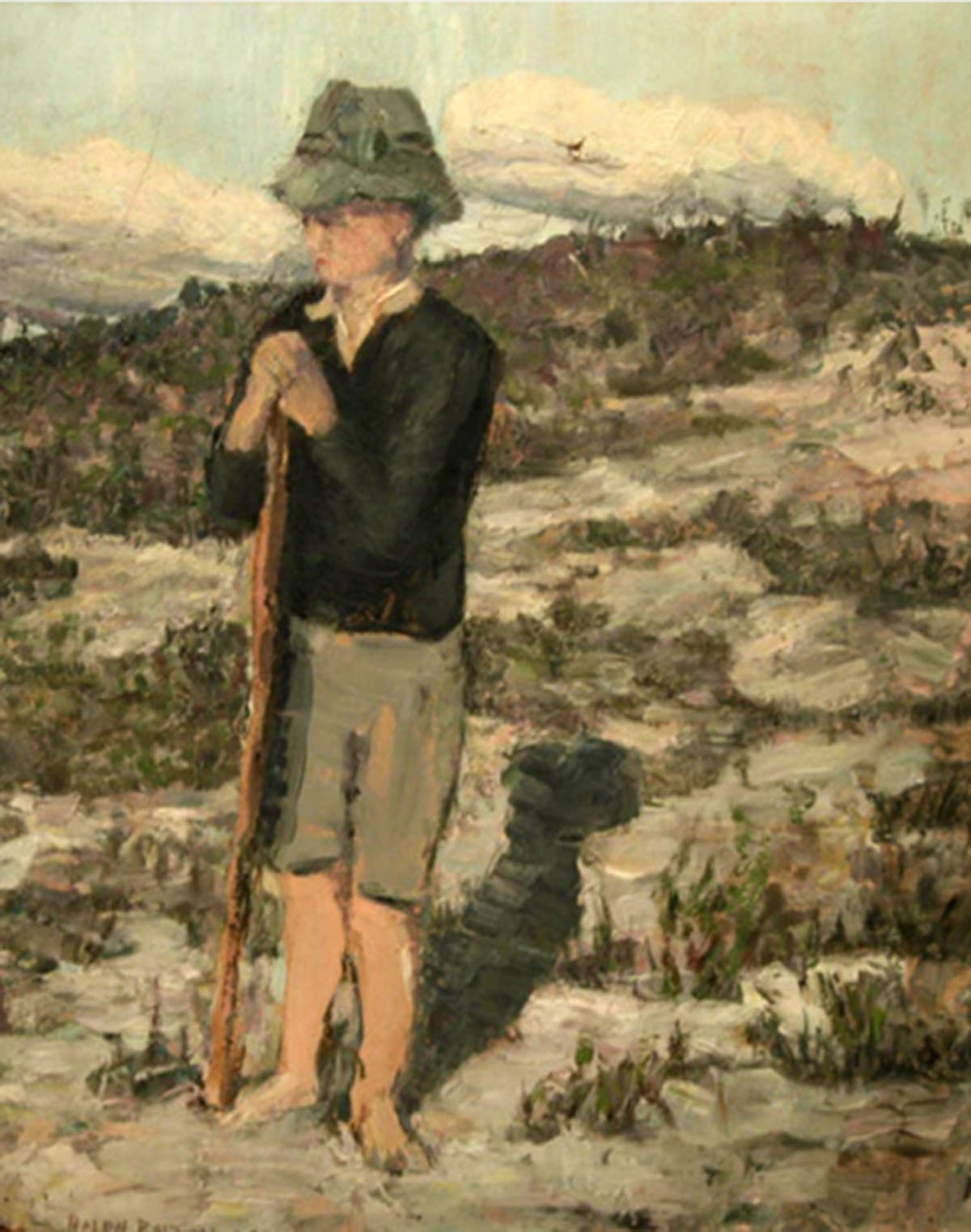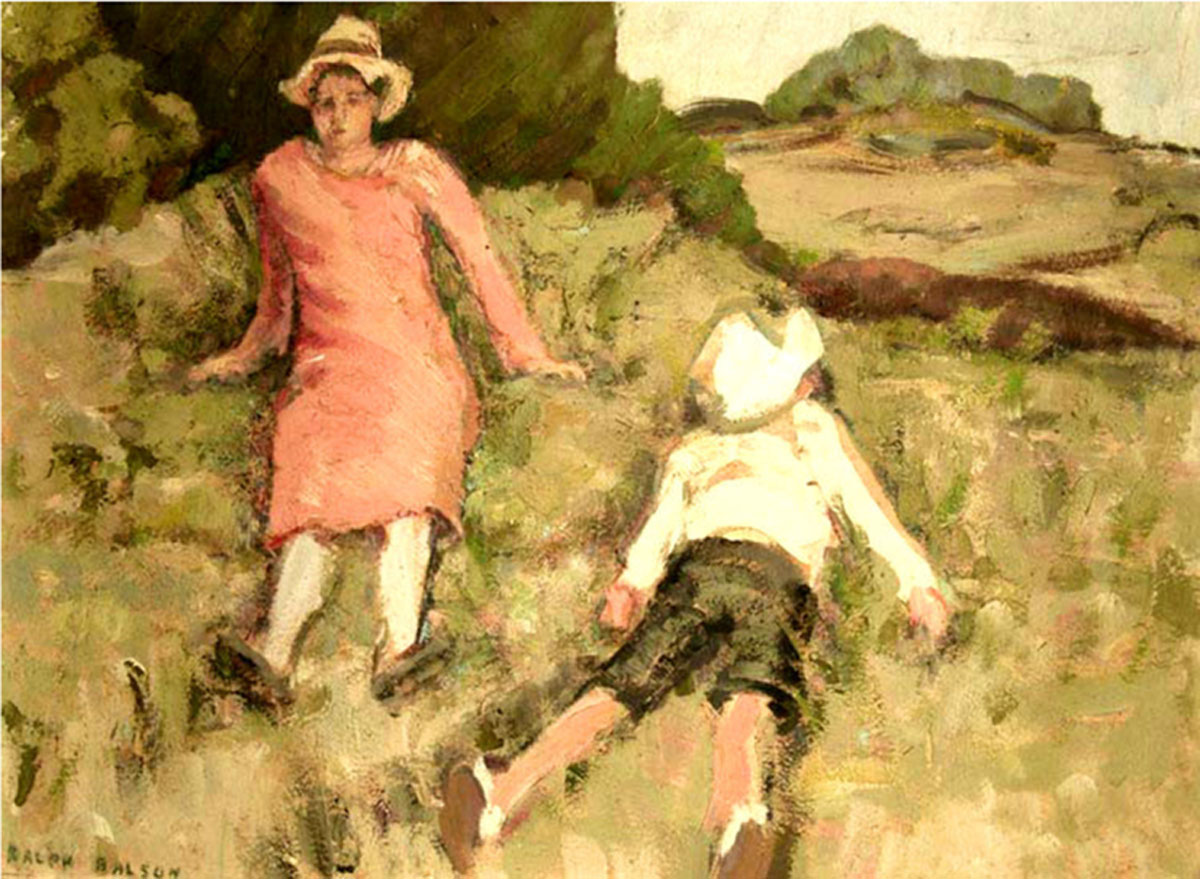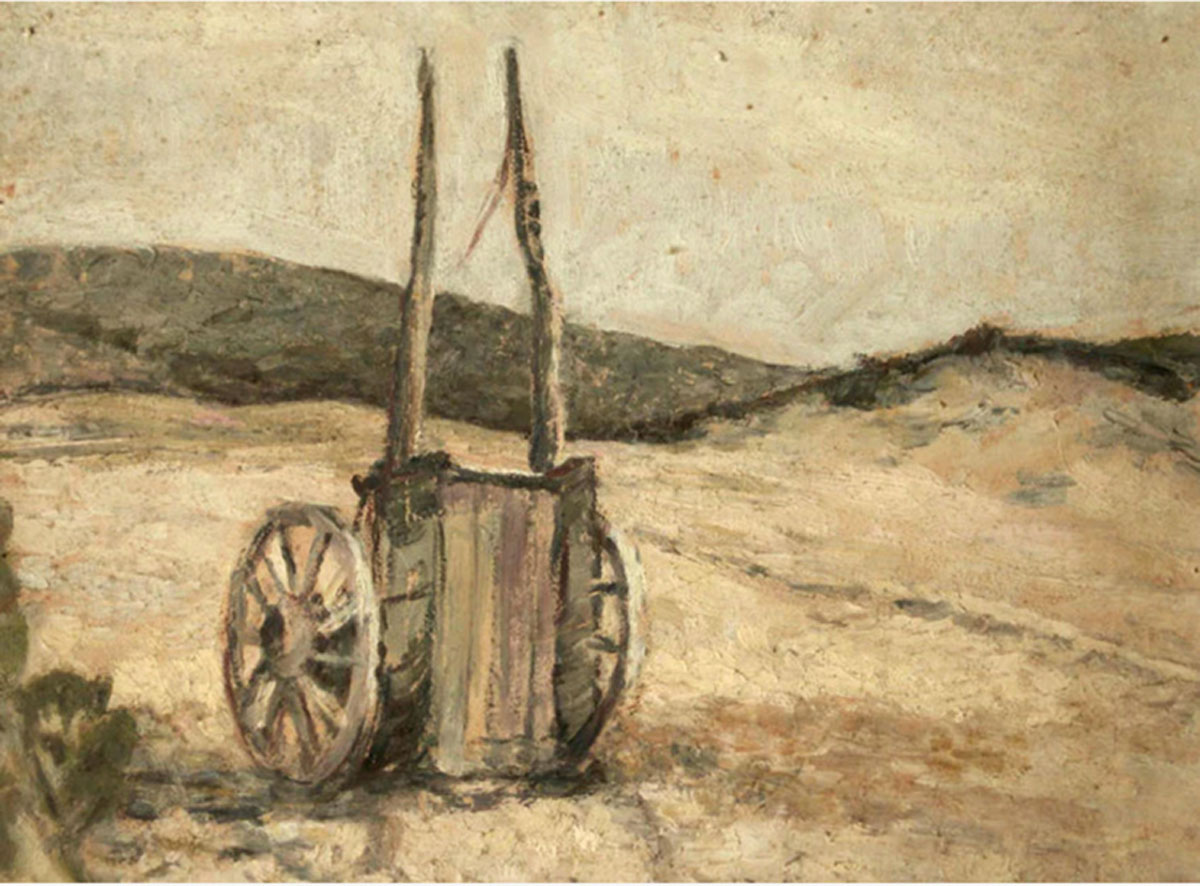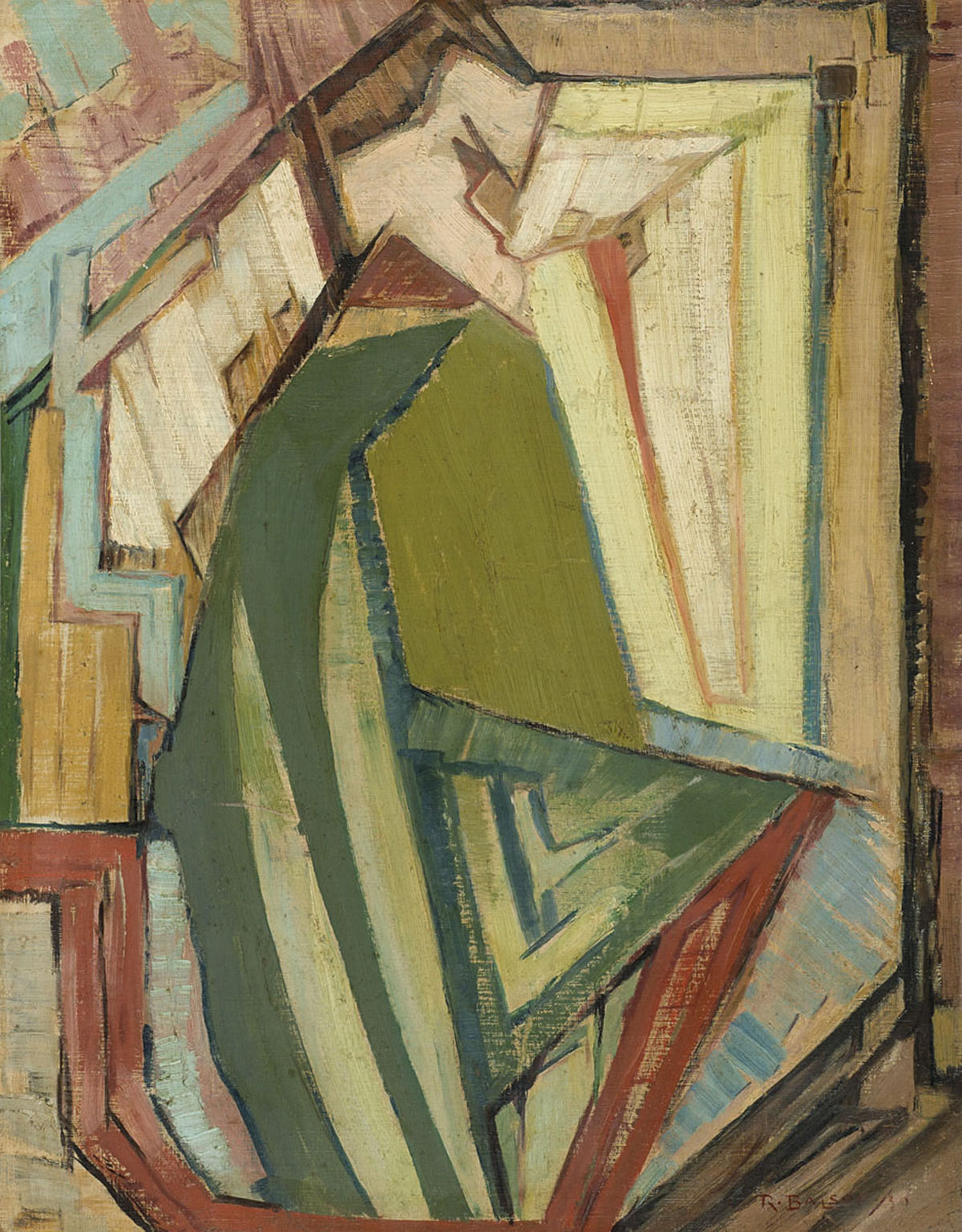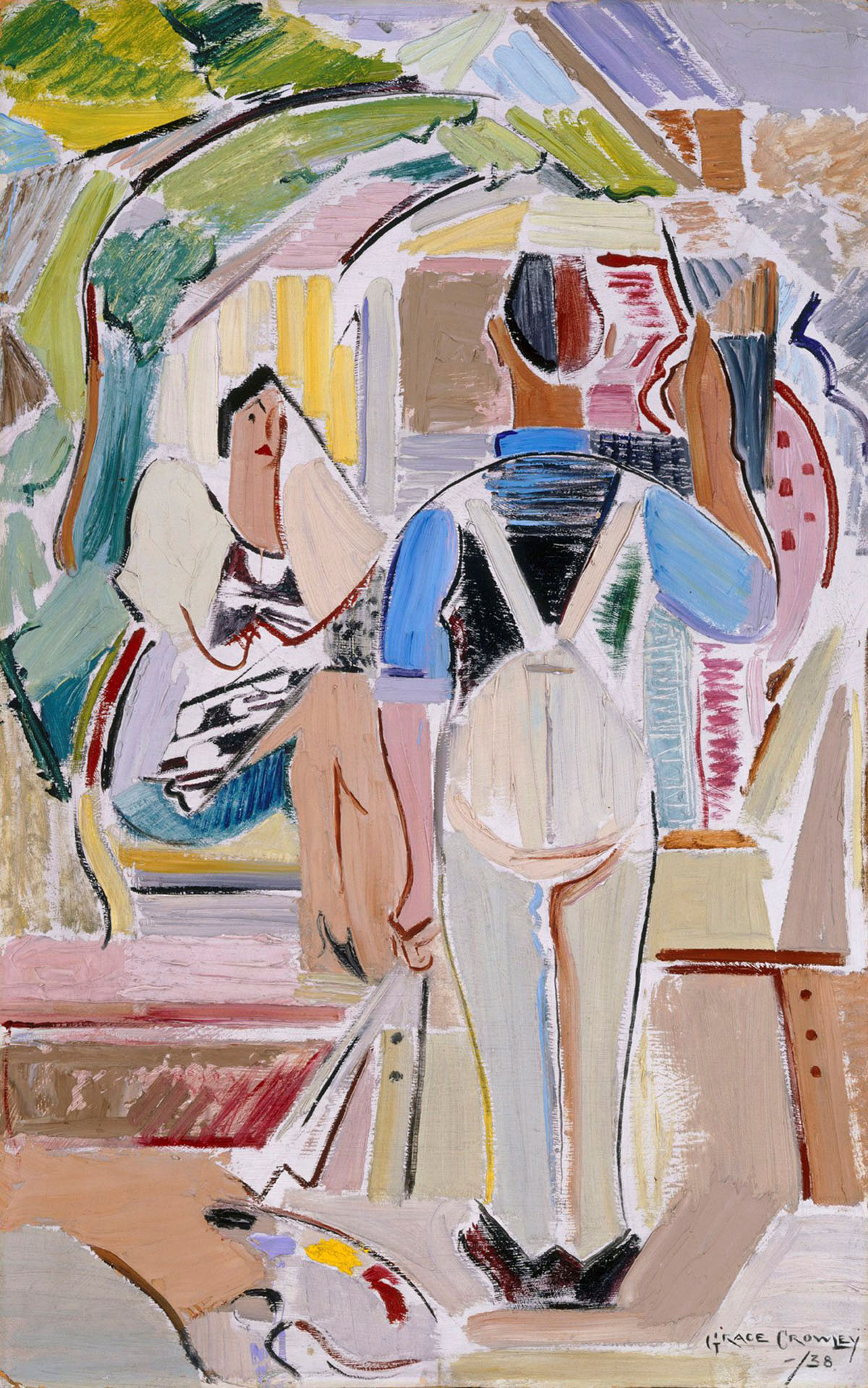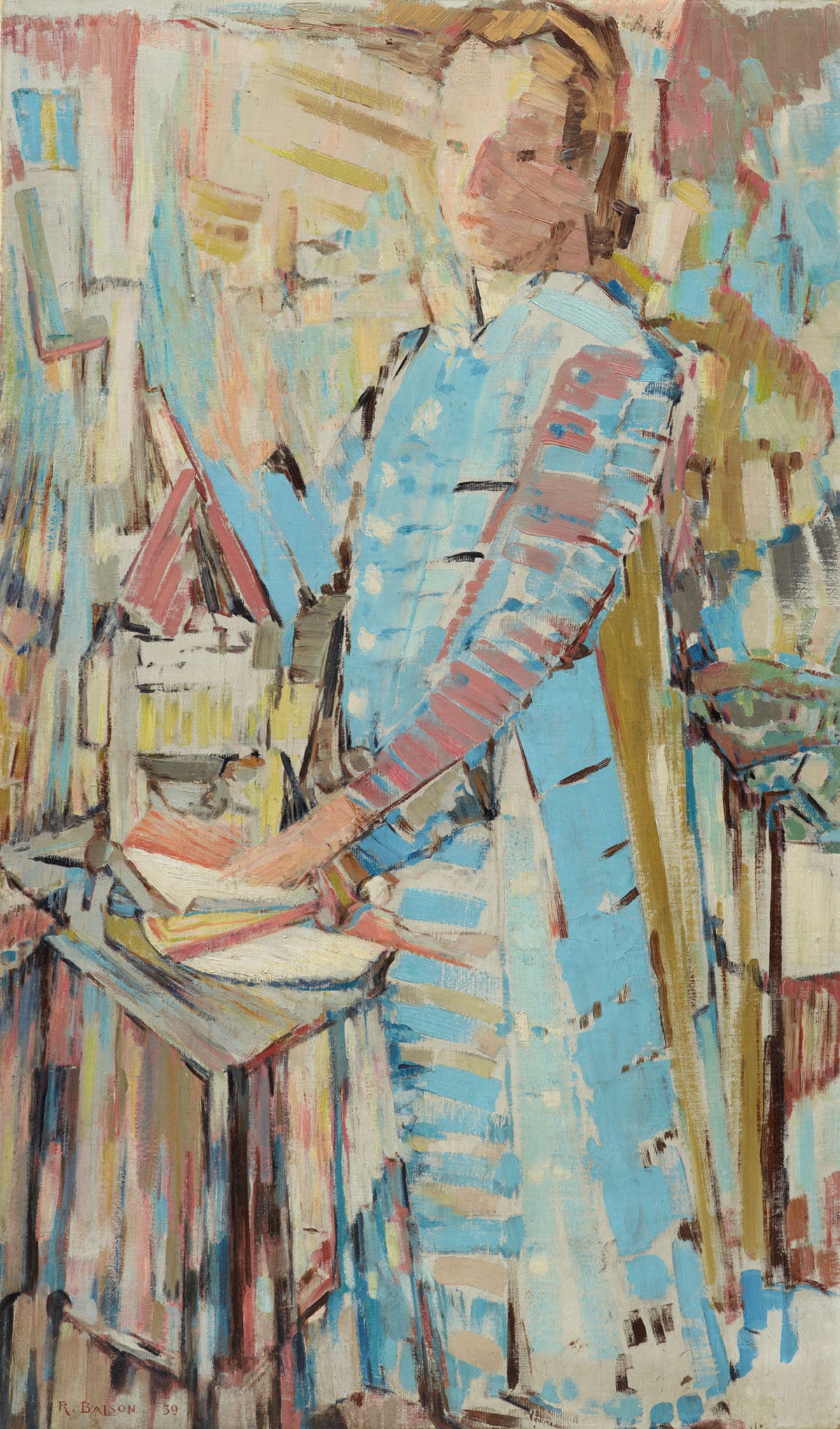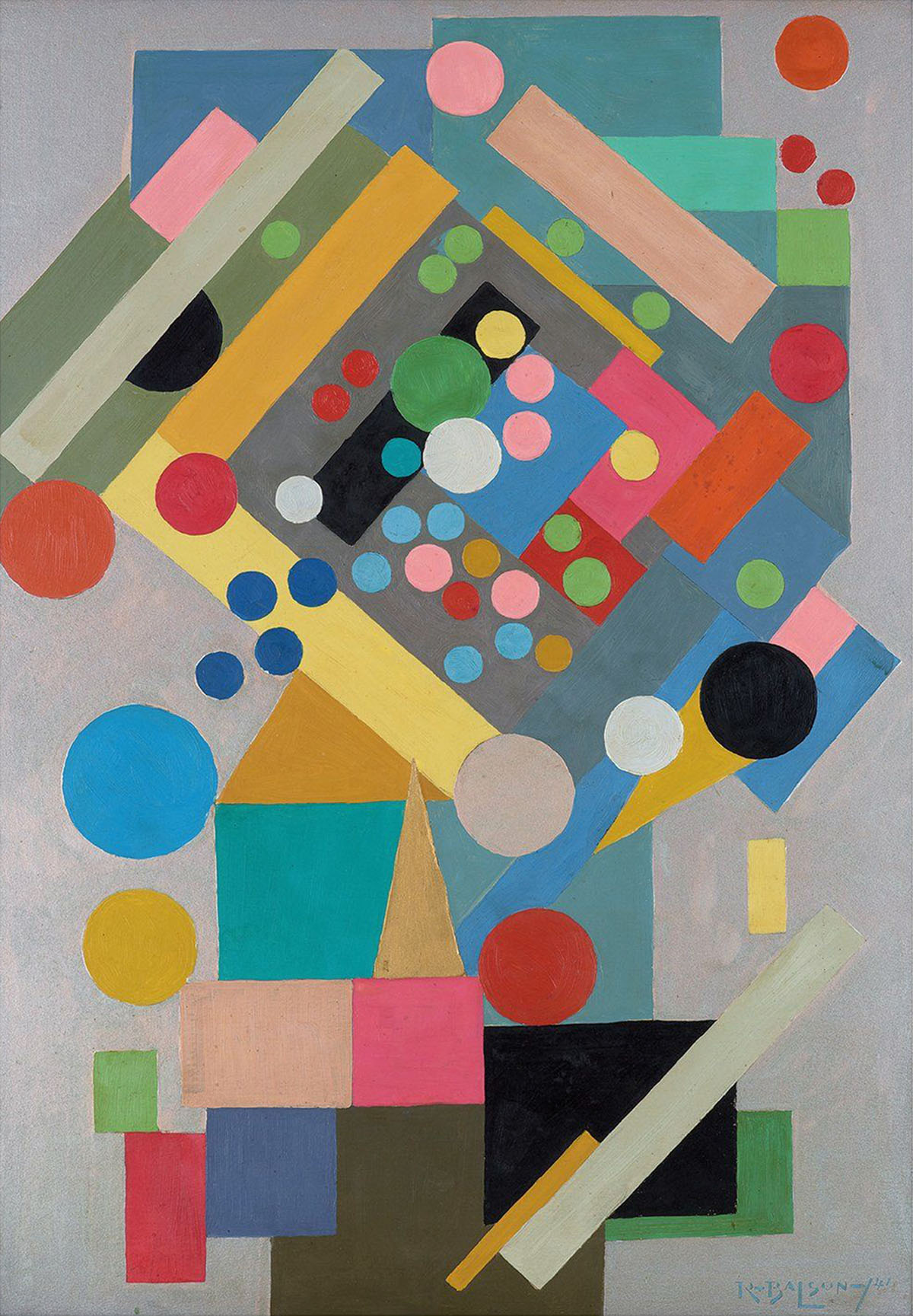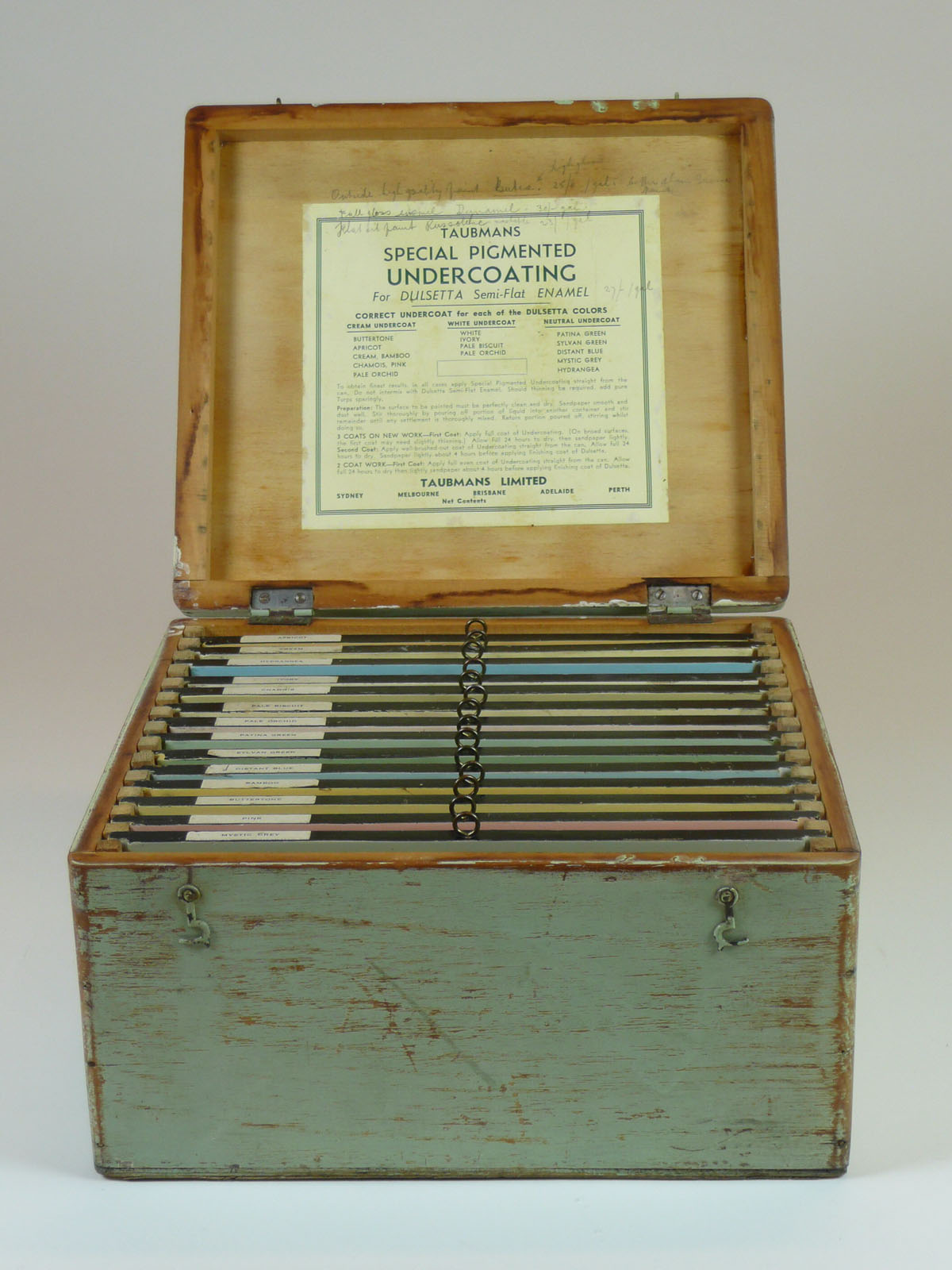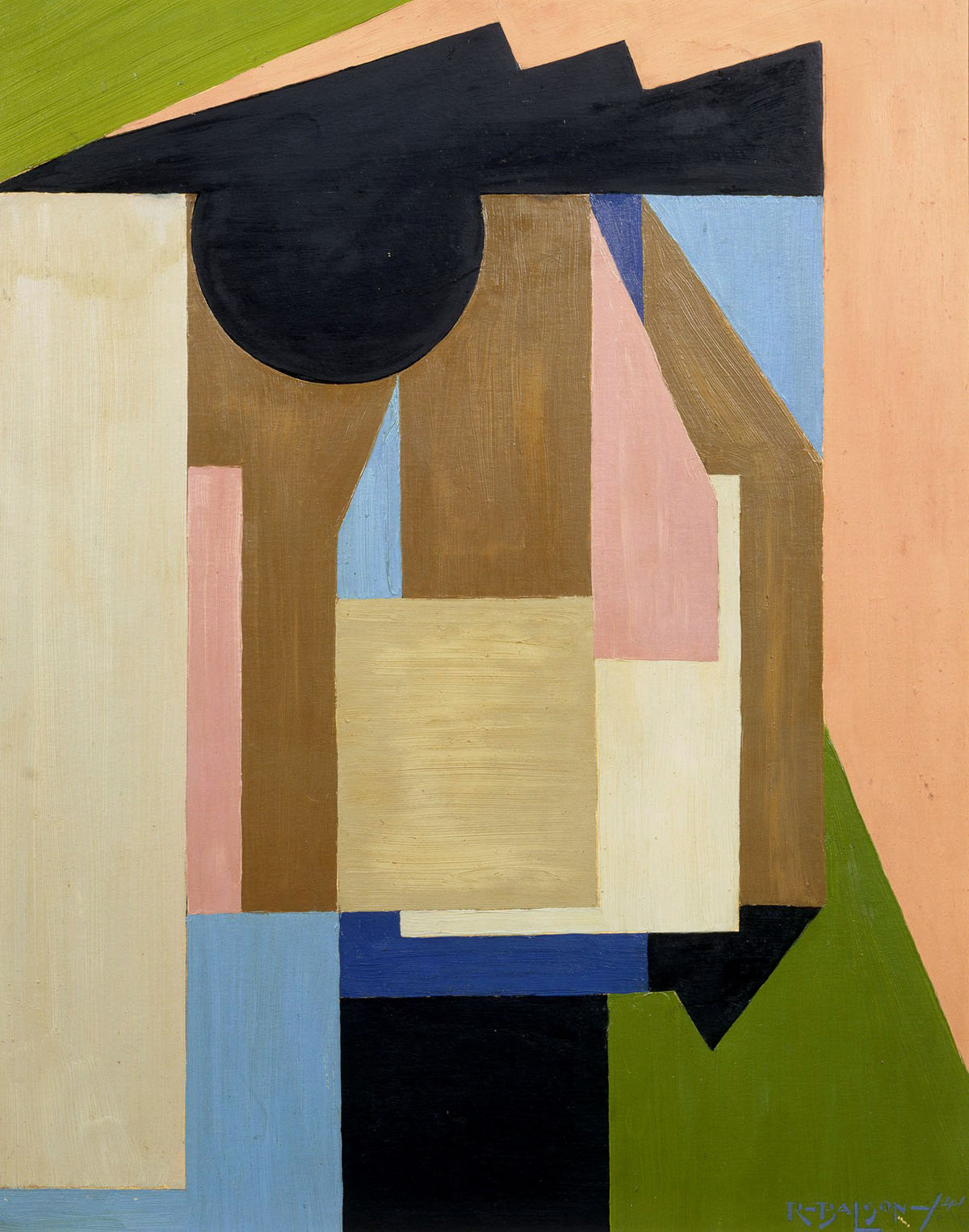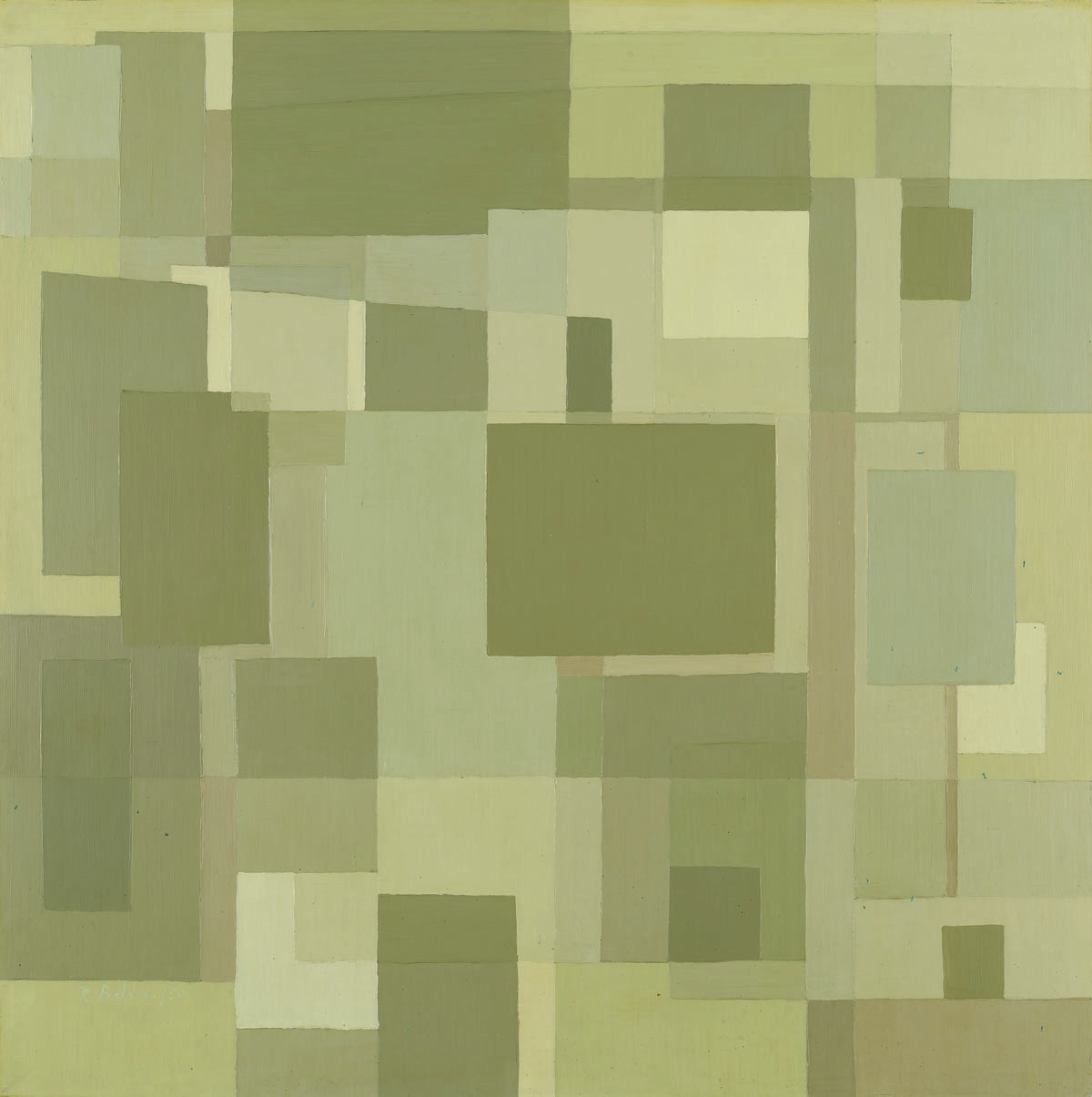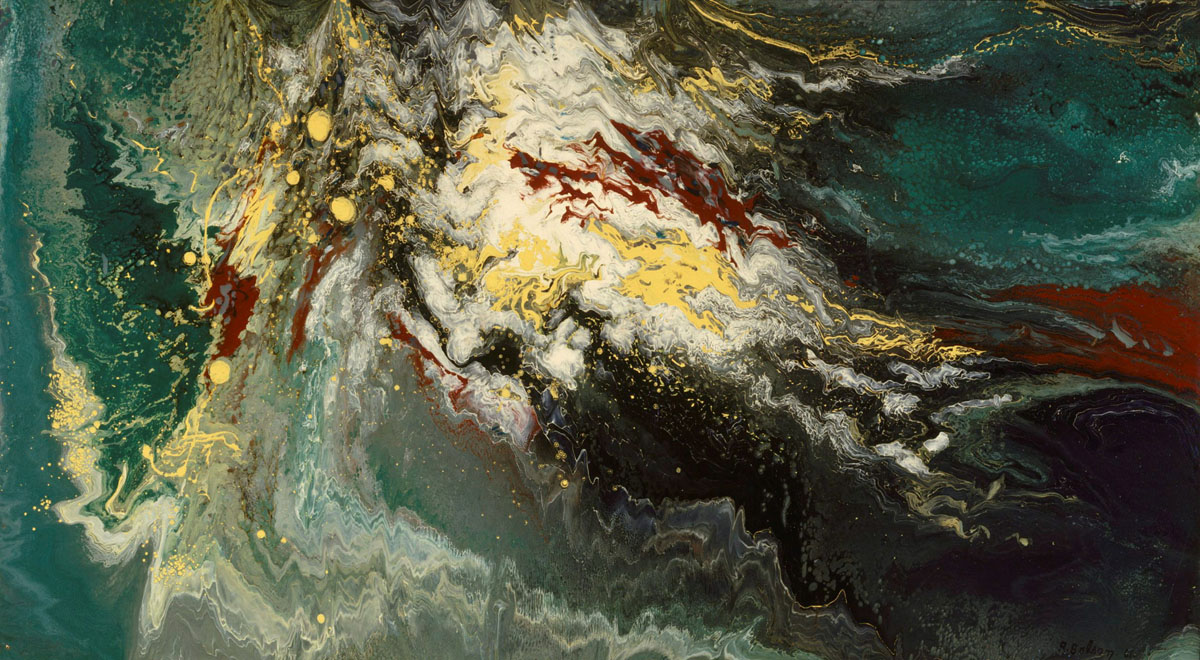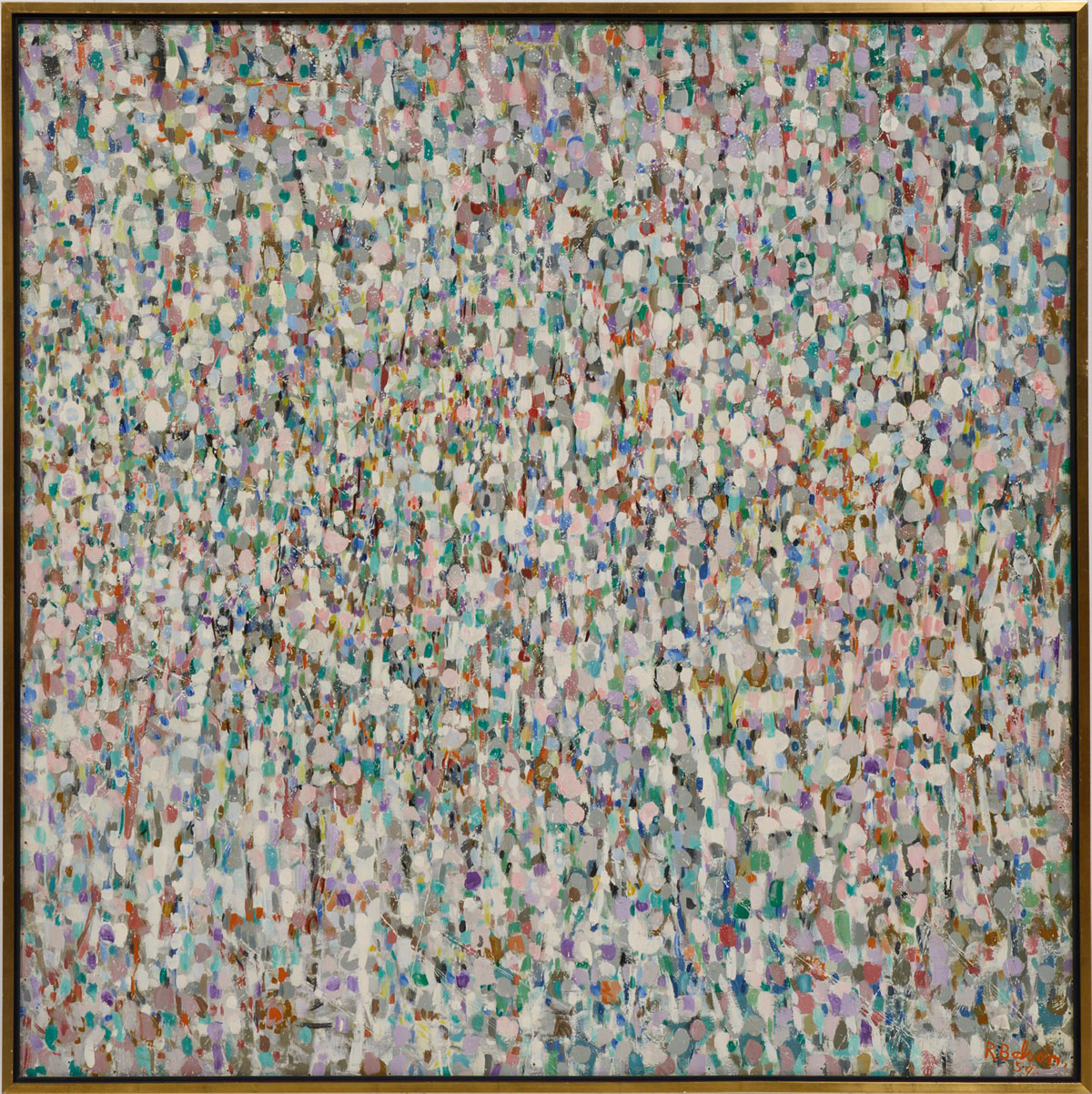Introduction
It is a curious fact of Australian art history that the first solo exhibition of purely abstract paintings was mounted in Sydney, 1941, by Ralph Balson, a working-class English migrant who laboured as a painter and decorator until his retirement at age 65 (Chambers and Whitworth, 2008). In the largely middle-class group of progressive artists working in Sydney from the 1930s on, Balson was an unusual figure who pursued his artistic ambitions around the demanding schedule of work and family life. Turning to art at the relatively late age of 29, his training was also local, self-directed, and idiosyncratic. Unlike his colleagues, he did not take the customary trip abroad to Europe or North America until the age of 69, and his acquisition of ideas relating to modern movements in philosophy and art came second hand—either from his own research or via his artist peers. Nonetheless, his contribution to Sydney’s avant-garde and its push towards non-objective art was decisive. As Herbert Badham (1949: 146) puts it, ‘He is a rare character in respect of his development without oversea experience from depictive tonality and the fashionable dilution of impressionism of two decades ago, to the abstract’. This paper considers the impact of Balson’s working class background and his trade as a painter-decorator on the subjects, methods, and materials of his art. Rather than parallel activities, it proposes that his trade shaped his artistic practice, contributing to its compositional and colouristic qualities as well as its materialist engagement with mid-20th-century science and philosophy.
In approaching Balson’s work and artistic relations, Raymond Williams’ distinction between class as category and formation offers a productive framework. Williams defines class as an objective socioeconomic category and the formation of class consciousness as entailing political and cultural representations of class identity (1988: 68). This distinction recalls Karl Marx’s apparent differentiation between a class in itself from a class for itself; the former having an objective place in the network of ownership relations and the latter an awareness of this situation, resulting in forms of organisation that defend its common interests. Next to category and formation, Williams adds rank: one’s ‘relative social position by birth or mobility’ (1988: 69). Rank suggests how one’s class position can be made as well as inherited and refers to social classifications that create belonging or exclusion. This essay looks to class as category in discussing Balson’s labour, education, and his general relationship to economic, cultural, and social capital. Class as formation enables a contrast between Balson and his contemporaries, such as Bernard Smith and Noel Counihan, whose writing and art was explicitly concerned with representations of economic and social life. While Balson expressed no comparable class consciousness, his abstract paintings can nonetheless be seen as representing the conditions of economic life through their application of trade skills and knowledge, and the creative exploration of the materials worked upon in the labour process. We argue that expression of these productive forces complements his materialist disposition and is a foundational aspect of Balson’s non-representational art. Balson’s class inheritance, upbringing, and adult life as a tradesman, in contrast to the essentially bourgeois Sydney art world, can be viewed as matters of rank. While affiliated with this scene and benefitting from collaboration with and patronage from its members—particularly Grace Crowley—Balson’s position in it was equivocal and he maintained an independent outlook and approach to artmaking.
For Balson’s contemporaries, class was a critical part of his art and social identity. His friend and collaborator, Grace Crowley, often remarked upon the advantages of his painter-decorator trade for his artistic development; Daniel Thomas, one of the first writers to assess Balson’s contribution to Modernism, was also keenly aware of the way Balson’s trade shaped his practice. Having an income outside of art was a ‘special advantage’ that protected him from ‘the corrupting pressure’ to create effects and sell work (Thomas, 1965: 250). Indeed, the painter’s son William described his father as a ‘quiet, gentle man who’d never push himself and didn’t care particularly that his paintings didn’t sell’ (Saw, 1968). However, in the secondary literature on Balson, class has remained peripheral. While studies of his work often acknowledge his status as a working painter-decorator, the influence of his trade background on his painting and the trajectory of his career has not been the subject of extended analysis. Bruce Adams’s (1989) valuable research has connected themes and developments in Balson’s practice to his biography that are essential for a study of his class identity and relations with his peers. Our paper builds on Adams’s work, but prioritises the experience and impact of Balson’s rank and labour. Adams’s (1980) examination of the influence on Balson’s abstractions of the writings of Piet Mondrian and Albert Einstein emphasises their non-subjectivity and creative embrace of changes in scientific perspectives on matter. Here, we view the depersonalised nature of Balson’s work as part of an aesthetic and philosophical materialism that links art and trade. While not specifically addressing Balson’s trade background, Deborah Edwards has described his understanding of colour harmonies and composition as empirical and idiosyncratic (2008a: 38–39). Moreover, she has connected his distinctive palette and use of metallic accents to the design schemes popular in the 1940s and 50s, incorporating Balson into the creative overlap between art and decoration that characterised Sydney Modernism (Edwards, 2008b: 35). In what follows, we consider Balson’s constructive works in relation to the kinds of interiors he would have been painting as a contractor. Indeed, we suggest that the house may have functioned as a geometric matrix from which his rectilinear abstractions emerged. Lisa Slade, on the other hand, has described Balson as a ‘housepainter-philosopher’ who combined the skills of trade painting with constructivist theories of art that had the potential to ‘revolutionise the art world’ (2013: 290). While Slade insists on the importance of Balson’s trade knowledge of the material and handling of paint, her short article remains speculative about its impact on his art. This paper explores several instances outside the scope of Slade’s text in which the work of the painter-decorator informs Balson’s approach to colour, composition, and brushwork, including his late ‘Matter’ paintings which rely on commercial tins of household enamel that can be poured directly onto the hardboard surface. Taking a broadly chronological approach, this article plots the points of intersection between Balson’s art and class background, from his early Post-Impressionist style oils to his late Matter paintings. In so doing, it explores his ambivalent place in the middle-class art scene and his rejection of representation commonly associated with class-conscious art. Moreover, we argue that his use of the materials, techniques, and spaces of his labour in his art elides the division between house and abstract painting.
House Painter
Balson’s social rank was established at his birth in Bothenhampton, Dorset, to journeyman baker Charles Frederic Balson and his second wife, laundress Martha Larcombe (England and Wales Census, 1901). One of nine children, including four half-siblings from Charles’s previous marriage, Ralph was educated at the village school and began an apprenticeship in Bridport at age 13 in 1903 (Adams, 1993). From 1911, he worked as a house decorator and journeyman plumber and, a year later, he emigrated to Sydney, Australia (Outgoing Passenger Lists 1890–1960). His reasons for emigrating remain unknown, but presumably relate to income and employment opportunity. An article in the Sydney-based Catholic Press (1902: 5) recommended the trade of painter-decorator as a ‘steady craft’ in which ‘a first-class man is seldom out of employment’. Minimum wages were set by the Australian Painter’s and Decorator’s Wages Board and ranged from 13 to 19 shillings for an eight-hour day between 1919 and 1925 (Construction and Local Government Journal, 1919: 5). In 1919, a maximum 44-hour working week was established: (The Journal, 1919: 1). Despite the relative strength of both wages and union, the painter was commonly regarded as an ‘ordinary tradesman’ and formed part of early-20th-century Australia’s large skilled labour workforce (Nicholls, 1928: 15).
Having painted houses since his teens, Balson did not turn to art making until the age of 29. His first known artworks were copies in pastel of paintings by 17th-century Dutch artists Caspar Netscher and Rembrandt (Adams, 1989: 47). Rather than first-hand transcriptions, these early works were likely done from reproductions in books and point to a self-directed interest in the history and practice of painting. Seeking formal instruction, Balson enrolled in part-time night classes at Julian Ashton’s Sydney Art School in 1922, where he continued until 1925 (Adams, 1993). Here, he was taught to draw from the life model, receiving instruction from Ashton, Henry Gibbons, Grace Crowley, and Anne Dangar, the latter of whom would be critical in shaping the direction of progressive art in 1930s Sydney.
Class enters Balson’s early works via his socioeconomic status as a tradesperson in Depression-era Sydney. By 1914 he had married Emilie Kathleen Austin, who had emigrated from Dorset to Sydney to join him (Adams, 1993). The couple and their three children, Winifred, Peter, and William, lived in the modest suburb of Pagewood in Sydney’s south. Balson’s pastels and paintings of the early 1930s drew largely on his direct experience, featuring family members and local scenery. A portrait of Peter Balson (Figure 1) shows the boy framed by the grassy rise of a sand dune and the clouds of a pale sky. The paint handling is mobile and sketchy, with multi-directional short strokes of broken colour adding light and movement. Balson’s painting style suggests an interest in Impressionist and Post-Impressionistic techniques that prioritise the artist’s subjective rendering of effects of light and colour. But unlike the cosseted children in beach scenes by Australian Impressionists Arthur Streeton, Tom Roberts, and Charles Conder, Peter Balson is barefoot and modestly dressed. Leaning on a lump of driftwood, he has an air of self-possession, able to construct his own imaginative world from the ready materials around him. A second portrait of Winifred and Peter (Figure 2) is painted with the same energetic brushwork that animates and unifies figures and ground. The pair are sprawled on the grass, in direct contact with the natural world. Without the umbrellas, baskets, and blankets of the bourgeois picnic, Balson’s children are cushioned only by sand and vegetation, protected from the rays of the sun by battered hats. A third painting (Figure 3), worked in a slightly rougher style revealing the composition board support, depicts an upturned mule cart, its shafts pointing skyward, in a barren-looking, sandy landscape. The subdued palette and emptiness of the scene give it a forlorn, impoverished air that may evoke the impact of the Great Depression during the early 1930s. His friend and painting partner Grace Crowley later recalled that Balson, like many, was devastated by the economic crisis and ‘would sit in the Domain in absolute despair’ (Nicklin, 1975: 11). Economic hardship was also noticed in a painting Balson exhibited at the Modern Art Centre in 1932, depicting ‘a Botany family’—perhaps the artist’s own—‘partaking of their meagre early morning meal’ (The Sun, 1932: 30).
The preponderance of family members and local scenery in Balson’s early work reinforce the fact that his art was made during leisure time, on weekends or after work. Not only did it depict the tradesman’s family, but it was also subject to the timetable of the working week. Regarding the pastels brought to the Sydney Art School’s monthly sketch clubs, Crowley remembered that ‘These were things not done on the spot like the other students but subjects he had memorised going to work. All the week whilst house painting he would ponder his problems and realise them at week-ends when at last free to paint’ (1966). Balson’s day job clearly imposed restraints on his engagement with art, but also shaped the development of his style and subject matter. Indeed, Crowley was convinced of the benefits this had for his art making:
Thus the necessity of earning a livelihood for himself and his family may have been in one way an asset. Even his house painting job accustomed him to handle large areas of paint with dexterity and ease; looking still further for blessings where others may have felt deprived, his comparative isolation from the usual art school training, which was only at night and confined only to drawing from the model in charcoal, forced him to seek further information about art in the public library (1966).
Crowley’s comments reveal two key impacts of Balson’s working-class identity on his work as an artist: the contribution of house painting to his artistic development and his auto-didacticism. Balson was, in a sense, continually in contact with paint, either as a material for painting houses or representing the world through an increasingly analytical lens. The long working week of designing colour schemes, mixing pigments, and painting surfaces reinforced a material and practical understanding of hue, tone, and harmony. Though the commercially prepared tins of pourable household enamel differed significantly from the small tubes of paste-like artist’s oils, the physical familiarity with pigments and their application was seen by Crowley as an ideal foundation for modernist art (Dredge, 2012: 53). The time spent at work also enforced a distance from art making that seems to have prompted a more intellectual, rather than observational, approach. This would later correspond to the constructive, post-Cubist methods favoured by the avant-garde painters in the Sydney art scene.
Furthermore, the desire to supplement his night classes drew Balson to the resources of the public library, where he devised his own curriculum, gaining an independent and informal education in art history and theory. Unlike his teachers and colleagues—Crowley, Dangar, Frank Hinder, and Robert Klippel—Balson did not travel overseas until he was 69, five years after his retirement from house painting and recipience of the old-age pension. Balson’s keen and eclectic reading resembled aspects of the more expensive programs undertaken by his artistic peers and it kept him impressively up to date with the many facets of Modernism (Thomas, 1965: 290–91). However, it also singled him out as a ‘stay at home’ who acquired his knowledge remotely (Crowley, 1966). By 1932, Balson had become involved in Sydney’s avant-garde and was included in the Exhibition of Progressive Art at Dorrit Black’s Modern Art Centre and The Contemporary Group shows at Blaxland Gallery in 1933 and 1934. This brought him into a solidly middle-class milieu of urbane, cosmopolitan artistic peers, most of whom had studied formally in various schools, ateliers, and academies in Australia and abroad. The frequent references to his trade as a house painter in newspaper reviews suggest the novelty and conspicuousness of his working-class status in the largely bourgeois Sydney art scene (Simpson, 1932: 3).
Becoming Modern
The most important of these middle-class colleagues was Crowley, with whom Balson shared a great personal and artistic affinity. Though born in the same year, Crowley’s social rank was strikingly different. She was the daughter of graziers and grew up on a large property in rural New South Wales (Thomas, 1993). Educated at the elite Methodist Ladies’ College in Burwood, her early artistic interests were supported by her uncle, Rev. Archibald Crowley, a Presbyterian minister, who took her to weekend classes at Julian Ashton’s Sydney Art School (Ottley, 2007: 19–20). Crowley enrolled there full-time in 1915, a decision that alienated her from her family who disapproved of art as a profession for a respectable middle-class woman and expected her to marry and raise a family (Ottley, 2007: 21–22). Uncle Archie, however, remained a staunch financial and moral support throughout her career. In 1918, she was appointed head teacher at the school, with Anne Dangar as co-assistant teacher from 1920 (Ottley, 2007: 23). Crowley and Balson developed a partnership that lasted from the early 1930s until Balson’s death in 1964. Their relationship gave the working-class, self-educated Balson access to the cultural elite of Sydney, with Crowley providing connections to patrons such as Mary Alice Evatt and Justice Bert Evatt, and sharing books and magazines on modern art and ideas. While Crowley remained a valuable benefactor, her relationship with Balson was highly collaborative and mutually beneficial, and together they worked toward a new form of modernist painting founded on constructive principles (Taylor, 2006: 41).
The progressive ideas Crowley shared with Balson were developed during her travels abroad with Dangar in search of Modernism. The pair studied under André Lhote at the Académie Lhote in Montparnasse between 1927 and 1929. After Dangar had returned to Sydney, Crowley worked in the studio of Albert Gleizes in Serrières in the South of France. Both Lhote and Gleizes pursued construction and abstraction over perception and impressionistic naturalism. For Gleizes, abstraction, or ‘pure painting’ was an inevitable result of the development of art after Cubism (Maloon, 2013: 243). The best art approached a deeper realism that was not achieved through imitation of surface qualities or appearances, but through a deeper understanding of form, colour, and consciousness. In their 1912 essay on Cubism, Gleizes and Jean Metzinger describe a painting as an autonomous, discrete ‘organism’ whose goal was to ‘express existence’ through the plastic means of art (2003: 201). Lhote, on the other hand, insisted on representation as the basis of art, though he too rejected imitation as meaningless and sentimental. Following Paul Cézanne, he counselled his students to be classic, workmanlike; to ‘see nothing in the nude, but the straight lines, the angles, the curves, the tones cold and warm, the large, small, medium-sized dimensions’ (Lhote, 2007: 75). Painting thus approached the abstract by prioritising the geometry and order underpinning natural phenomena, communicating the essence of the object through proportion, rhythm, and tone.
When Crowley established her own art school with Rah Fizelle in Sydney in 1934, these modernist principles, along with the theories of dynamic symmetry formulated by Jay Hambidge, constituted the curriculum (Free, 1966: 5). In her notes for a talk at the school in 1936, Crowley propounded the value of ‘interpretative’ rather than ‘representational’ vision, which looked in the subject to be painted for the objective and abstract qualities of design (2007: 123). She describes this process of picture building thus: ‘A Fizelle-Crowley student got into the habit of selecting a limited range of colour, simplifying each colour into a large geometric plane, arranging the shape one with another with an eye to their proportions and relationships’ (Adams, 1980: 186).
Constructive principles had a considerable impact on Balson’s paintings of the late 1930s, made at weekends in the Fizelle-Crowley studios. In Woman in Green (1939; Figure 4), the seated figure of a woman in profile has been analysed into its constituent colours and shapes. The folds of fabric down the curve of the back have been gathered into chalky green and white verticals, the upper arm massed into an olive polyhedron, and the leg divided into projecting green triangle and acute red angle. On either side of the figure, light and space are rendered as fragmented, shifting planes. To the right, they are arranged in orderly, vertical stripes, while on the left, diagonal brushstrokes of powdery blue and bruised pink, suggest the angle of light, or the brilliance of sky through a window. The busy contrasts of cool and warm hues—blue and pink, green and yellow, red and grey—are restless and energetic, radiating outward from the figure like an aura. The articulation of light, space, and form through angular, unblended brush strokes emphasises the flatness of the picture plane and the material reality of the paint applied to it. In its semi-figuration abstracted from nature, Woman in Green realised the progressive ambitions of Sydney painters in the late 1930s. Indeed, the work was included in Exhibition I, a group exhibition of work by Frank Hinder, Crowley, Fizelle, and Balson that was intended as the first in a series of shows announcing abstract art in Sydney, and offering, as modernist Eleonore Lange (1939) put it, ‘a new realm of visual experience’.
Balson and Crowley painted portraits of each other, offering insights into their shared artistic influences and class differences. Crowley’s The Artist and his Model of 1938 (Figure 5) depicts Balson at the easel in the rooftop garden of the George St studios, painting his subject. His canvas bears only a vague resemblance to the scene before it, showing him seeking out its abstract values in the manner taught at the Fizelle-Crowley School. Balson is wearing the apparel of his trade: a flat cap, blue-collared shirt, and black waistcoat under white painter’s overalls. The hue of the painter’s raised arm and nape is decidedly darker than the model’s. While this may be formal experimentation, it nonetheless suggests the manual and often outdoor aspects of Balson’s work. The model, by contrast, is an urban sophisticate. Wearing high heel shoes, a slim dress in a bold print, and hair cut in a fashionable bob, she is representative of the city’s à la mode art scene. The painting’s title is also instructive, marking Balson out as the artist and not one of Crowley’s students from the Sydney Art School. At the same time, the description of the sitter as a model depersonalises the artwork in a manner consistent with the disinterested formalism practised by Lhote. In his tradesperson’s clothes, Balson epitomises the ‘workman-like’ approach to colour, shape, and line that Lhote had advocated. While Crowley remembered this painting as a ‘whimsical colour sketch’ it nonetheless satisfied the demands of the portrait, producing a convincing likeness. ‘To me’, she said, ‘it looks exactly like Balson. He had no need to turn around to show that he is Balson’ (1975). The house painter’s overalls and flat cap do more to identify him than the outlines of his face and suggest his singularity in the Sydney art scene.
However, Balson’s Portrait of Grace Crowley painted a year later (Figure 6), does evoke a teacher-student relationship, with Crowley in the role of teacher. Crowley is depicted reverentially from below, her hand pointing to an open page in a book placed upon a lectern-like structure. She wears a gown, most likely a painter’s smock, that takes on a voluminous, ceremonial quality. The painting’s style also demonstrates the modernism taught by Crowley through its limited palette, deployment of colour in geometric planes, flattened space, and emphasis on the two-dimensional plasticity of the surface. Around the figure, light and space splinter into brilliant shards of pink, blue, cream and ochre, as if to suggest Crowley’s revelation of a new manner of seeing and representing. Yet Balson’s treatment of the school’s methods is heterodox. Adams, noting the Fizelle-Crowley influence on Balson, adds that the ‘portrait is direct and painterly in style, it has a freshness indicative of a more intuitive and expressive approach than the ideas of the group’ (1980: 186–87). This stylistic independence mirrors Balson’s ambivalent position in the school’s circle: an associate, a collaborator, and a decorator, but never a student or teacher.
Balson’s marginal status in the Sydney art scene may have been underlined by the tangible evidence of his trade. From 1932, Balson used the Fizelle-Crowley school studios to paint at weekends, but he also ‘made a gift to the new school by painting it throughout’ in his capacity as a house painter (Free, 1966: 6). Later, in 1938, when Balson and Crowley were sharing a studio with Frank Hinder, an incident occurred that revealed underlying class tensions. Having received a catalogue of the 1937 exhibition of non-objective art at the Guggenheim, Hinder offered to lend it to Crowley and Balson for further study, jokingly reminding Balson ‘not to pinch any plates’ (1972). In a 1972 interview, Hinder explained that this was a reference to the ‘scarcity of books and magazines in those days’—but the joke backfired, as Hinder recalled:
Ralph felt that he was being accused of stealing the book plates. As a house painter, people would watch him suspiciously – one woman even locked her house up, and made him use a ladder to climb through a window to paint the bathroom. Because of this, he took my joking remarks seriously, and was very upset about it.
The ensuing frostiness between Balson and Hinder caused the latter to leave the studio. Though Dianne Ottley, in her book on Grace Crowley, views this as an indication of his lack of social and artistic confidence; it reflects more clearly Balson’s experience of class-based prejudice in his working life and sense of class difference in the Sydney art scene (2010: 95).
Constructive Painting and Non-Subjectivity
By 1941 Balson had wholly departed from representational painting, leaving behind the personal, figural subjects of the early 1930s and their implicit connection to his working-class background. He had also moved beyond the influence of classicising Cubism that he encountered through the Fizelle-Crowley group, arriving at a more radically abstract position evident in his Constructive series. Working privately alongside Crowley and focusing exclusively on an abstract art of relations, the pair pursued geometric abstraction in partial seclusion from the Sydney art world for the next two decades (Adams, 1980: 187).
Balson’s 1941 solo exhibition at Anthony Hordern’s Gallery was the first public presentation of his Constructive paintings and, significantly, considering Balson’s outsider class status, the first solo exhibition in Sydney of purely abstract, or non-objective art (Truth, 1941: 32). The works in the exhibition explored colour relationships through opaque, superimposed geometric forms in a palette of mint green, dirty pink, baby blue, ochre, brown, grey, and metallic accents of silver, gold and bronze (Figure 7). Black was used sparingly to create void-like spaces. Balson favoured solid verticals, right-angle triangles, full circles, half rounds, and rectilinear shapes, sometimes resulting in architectonic compositions. Vertical shapes contrast with diagonal lines to create compositional tension, horizontal lines establish harmony, and floating circular forms animate the surface. While the focus is on flatness and the two-dimensionality of the picture plane, the works maintain a painterly quality: the artist’s hand is evident in deliberate brushstrokes, visible bristle lines, built-up passages, and smudged tape lines.
Curiously, the artist’s hand is not evident in his signature, as Crowley signed each painting for Balson in elegant capitals. This may have been an aesthetic consideration, given the moderne quality of Crowley’s script, its angular lines echoing the modernity of the paintings (Edwards, 2008a: 40). It may also suggest the collaborative nature of their practices, or even Crowley’s patronage of Balson’s career. Yet Balson’s indifference toward signing his work also speaks to his mid-career rejection of subjectivity in art. His constructive period prioritises the depersonalised exploration of colour harmonies and geometric shapes that evade any direct connection with emotion, psychology, place, or experience. In the rejection of individual experience as the basis of art, we see the influence on Balson of Piet Mondrian’s Neoplasticism. Balson had access to these ideas through the English translation of Mondrian’s essay ‘Plastic Art and Pure Plastic Art’, published in the anthology Circle: International Survey of Constructive Arts in 1937 (Adams, 1980: 183). Mondrian’s essay argued that while art involves an unavoidable balancing act between the object of representation and the artist’s subjectivity, modern painting should strive to free itself from the individual expression that ‘veils’ universal beauty or the pure relation of forms. The non-representational painter was better placed than the figurative one to free themselves from the ‘domination of the subjective’ and thus to express the underlying essence of reality. Like science, a pure and disinterested art strives to unveil the hidden and unchanging laws of reality; ‘the mutual relations that are inherent in things’ (Mondrian, 2003: 388).
In a letter to Michel Seuphor, Balson claimed Mondrian to be his greatest single influence and ‘the only really abstract painter’ (1955: 126). Mondrian’s insistence on ‘neutral’ forms of geometry as a means of uncovering a deeper law of reality can be seen in Balson’s disavowal of subjectivity and reduction of painting to a set of formal and plastic relations. Balson writes of his abstractions to Seuphor: ‘I believe that painting should penetrate deeper into the mystery and rhythm of the spectral, which means digging into existence itself’ (126). This statement corresponds with what Mondrian describes as the ‘true road’ for modern art: ‘not the expression of the appearance of reality such as we see it, nor the life which we live, but … the expression of true reality and true life … indefinable but realizable in plastics’ (Mondrian, 2003: 390). Eschewing the connection between art and perceptual experience, Balson thus abandoned observation and, on a surface level, any direct engagement with the subject matter of class.
Class Consciousness in Australian Modernism
As a working-class artist painting in a depersonalised, abstract mode, Balson’s art was distinctly at odds with the figurative, realist style associated with class consciousness in 1940s Australia. For art to reveal the nature of social organisation, the view of Marxist art historian and critic Bernard Smith was that it needed to speak through a representational language of form that prioritised human experience. In his 1944 essay, ‘The New Realism of Australian Art’, Smith described Modernism, particularly its abstract tendencies, as leading to ‘aesthetic isolationism’ (2006: 467). However, he noted approvingly that this tendency has been countered by ‘a trend toward realism in which the previous insistence upon abstract values has given way to a new representational art’ (465). This new trend was evident in international art by the Mexican muralists Diego Rivera and José Clemente Orozco, and the Neue Sachlichkeit of Otto Dix and George Grosz, who had each moved through a transitional and developmental period of abstraction but ultimately rejected it in favour of realism. Smith considered this path back to reality critical in fighting the rising tide of fascism, which fostered mysticism and idealism at the expense of the material conditions of life (2006: 467).
In Australia, this new realism emerged in the expressive figurative paintings of Russell Drysdale, William Dobell, Douglas Watson, Arthur Boyd, and Noel Counihan. Counihan was, for Smith, the most significant of these painters and both were active in the Australian Communist Party. Smith’s ‘The New Realism in Australian Art’ was partly a defence of the position taken by Counihan in his heated debate with the painter Albert Tucker in the art and literary journal, Angry Penguins, through 1943–44. Counihan and Smith mutually rejected claims of art’s unchanging essence and autonomy from social context, arguing instead for ‘art as social activity’ (Smith, 2006: 468). Counihan’s realist illustrations, linocuts, lithographs, and paintings were committed to illustrating human suffering in capitalist society by focusing on the material and economic conditions of social life. Most importantly for Smith, Counihan’s work was an expression of class consciousness:
Counihan’s art has grown directly from his own experience and political faith. He knows the people he paints and identifies himself with their lives; the mothers prematurely aged by poverty and domestic squalor, the dole queues, the old men and women waiting through the day at the out-patients department of the public hospitals, the miner with the dusted lung (Smith, 1976: 4).
Counihan’s subject matter and realist style was inherently political, cognisant of the potential consequences of aesthetic isolationism and its narrative silence (Smith, 1976: 3). In this sense, he becomes the Australian painter par excellence of a type of class-conscious social realism.
By 1959, the argument for realism had solidified into a manifesto. Smith’s Antipodean Manifesto was constructed from various statements made by self-described Antipodean painters working in an expressive, figurative style. Charles Blackman, Arthur Boyd, David Boyd, John Brack, Bob Dickerson, John Perceval, and Clifton Pugh undersigned the manifesto, which accompanied an exhibition of their paintings. It critiqued French and American post-war abstraction—Tachistes, Action Painters, Geometric Abstractionists, and Abstract Expressionists—and defended the figurative image as a type of language through which the artist speaks, makes meaning, and contributes to social life (Smith, 1976: 165–66). While the manifesto embraced the liberating potential of earlier formal experimentation that freed the artist from naturalism, it rejected abstraction as an end in itself. Pure abstraction may be beautiful and affecting, but it does not rely on perceptual information or communicate experiences shared by artist and viewer. Indeed, the manifesto describes non-figurative art as mute, as it ‘reduces the living speech of art to the silence of decoration’ (Smith, 1976: 165). Preserving representation was vital for Antipodeans due to its narrative potential and ability to participate in history (167). The figurative image was thus seen as the ‘humanisation of nature’, and people, along with the social contexts and histories that shaped them, situated at the heart of all aesthetic, social, and moral inquiry.
Art from Labour
Balson’s art, in many regards, is antithetical to Smith’s call for a figurative realism that attempts to make sense of social experience. In his art and statements, there are no expressions of class consciousness or critiques of the political economy of capitalism. Historical events Balson witnessed—the Second World War, the threat of fascism, and debates in Australian art and society—pass without comment and leave no discernible trace in his paintings. In this regard, Balson’s work epitomises the ‘silence of decoration’ critiqued by Smith. Indeed, in an essay of 1947, Smith describes the Sydney avant-garde to which Balson belonged as ‘an art without associations either moral or literary but concerned with the fundamentals of structure and design’ and suggested that in some cases, this ‘mathematical’ art was ‘reduced to a kind of pattern-making’ (1976: 53). Balson’s art was aesthetically autonomous rather than embedded in social context or, to use Smith’s terms, a form of aesthetic isolationism eschewing ‘involvement in life’ (1976: 166).
However, Balson’s art is embedded in the experience of class because of its connection to labour. Whereas Counihan depicted people whose lives were shaped by toil, Balson was himself a member of the working class whose artistry developed out of his labour processes. The methods, materials, and knowledge of house painting emerge in his abstractions, making the inherently social world of work inseparable from his art. Crowley had envied him his dexterity in handling colour, tonal values, and large areas of paint, and had advised her students that the skilful use of colour was ‘not to be found in textbooks’, perhaps with Balson in mind (2006: 124). Late in life, she claimed that Balson was ‘born a completely abstract painter. He was born that way, while I had to be educated that way’ (1966). In admiring Balson for having been blessed with these powers, she perhaps overlooks their long and arduous acquisition from the age of 13.
The success of the painter-decorator depended on the careful preparation of surfaces and paint, and dextrous laying-off. It also required an understanding of hue and tone, which included the mixing of colours and their combinations. Balson was regularly singled out by reviewers for his use of colour. Though the 1941 solo exhibition was criticised as bordering on sterility, he was praised for his ‘excellent colour sense and feeling for design’ (Sydney Morning Herald, 1941: 7). In fact, the pastel colours used liberally in Balson’s Constructive paintings—particularly soft pinks and greens, pale blues, off-whites, and mushrooms—were popular house interior colours throughout the 1940s until their replacement in the 1950s by hues of greater intensity and vibrancy (Cuffley, 2007: 191). The Taubmans ‘Dulsetta’ semi flat enamel paint sample set, held in the collection of Museums Victoria (Figure 8), reveals the potential influence of contemporary interior colour schemes on Balson’s artistic palette. The sample set, produced in the late 1940s or early 50s, was distributed by Taubmans’ retail branches, including a location in Sydney, for the use of tradespeople and interior decorators. Representative of the temperate colours of the 40s, the samples are composed of soft pastels in blue, pink, green and cream. Indeed, Balson’s Painting (1941; Figure 9) approximates many of the colours in the swatch set: apricot, ivory, cream, hydrangea, and pale orchid. In this sense, Balson likely selected and combined the domestic colours he was familiar with through his trade into a broader artistic palette.
The painter’s trade also informs Balson’s technique and paint handling. The Painter’s and Decorator’s Guide, a mid-century manual for apprentices in Australia, prized smoothness and ‘even pressure and uniformity’ (Wallis, 1947). Such impersonal characteristics are evident in Balson’s Constructive works and perhaps explain the lukewarm reception of the 1941 exhibition and the charge of ‘sterility’. More recent discussion has noted Balson’s ‘elision of the brushstroke, his choice of smooth paperboard surface and his confidently hand-wrought geometric forms [that] demonstrate skills he developed painting houses’ (Slade, 2013: 290). Balson’s deft and precise paint application is not in question; however, his brushstrokes are not, in fact, elided. Bristle marks are visible in many paintings in the Constructive series: even and consistent, these marks follow the direction of forms, moving vertically with tall rectangles, horizontally with shapes laid width-ways, around circles, and diagonally with triangles. Creating subtle striations that catch the light, these uniform marks also make a virtue of the painter’s steady hand in laying-off or dragging paint.
While no common trade defects are visible in Balson’s paintings, such as blooming, blistering, cracking, and flashing, the hand of the artist is always tangible, especially in the build-up of paint where the edges of forms join. The result of cutting in, this build-up is described as a ‘fat edge’ in the painter and decorator’s trade and viewed as a product of ‘bad workmanship’ (Wallis, 1947: 11). In the Constructive series, Balson uses the occasional fat edge as a painterly effect that prevents an entirely flat and homogenous surface; here, Balson appears to break the rules of his trade for aesthetic ends. However, in the Constructive works of the early to mid-50s, he adhered to glazing techniques used by painters and decorators to create the appearance of depth by ‘applying successive glazing coats., i.e., coats of transparent colour’ (10). Balson uses this same technique in paintings such as Abstraction (1950), Constructive Painting (1951), and Painting (1953), where multiple glazes of hues varying in value create the subtle illusion of depth and transparency.
The techniques and conventions of Balson’s everyday labour—laying-off, cutting in, glazing—provided adaptable methods for his abstractions. Yet the geometry of his forms, with their architectural relations, also evinces his labour. The shapes and spaces of the Constructive series are strikingly reminiscent of the houses that formed the sites of Balson’s trade. In Balson’s Constructive Painting of 1950 (Figure 10), rectangles of varying dimensions and tones are arranged parallel and at slight angles to the picture plane, creating a sense of spatial depth. Painted in a reduced palette of beige, taupe, and warm grey, the colour scheme is evocative of the subdued wall colours popular for house interiors through the 1940s and early 50s. The shapes themselves are suggestive of the planes and apertures of the home; the wall surfaces and cornices, the windows and doors framed by architraves. Tonal variation in the superimposed rectilinear shapes also calls to mind the shadows and shifting light effects within a naturally illuminated interior over the course of a day.
While this reading of Balson’s work may seem iconoclastically literal, it is not unreasonable to expect that the spaces in which the artist spent his working week might have found their way into his repertoire of abstract forms. It is easy to imagine the furniture of the house and its bright decorations swathed by canvas drop cloths, focusing the eye on the muted planes of the freshly painted interior. Indeed, the house constituted a matrix of geometric shapes that corresponded to the pure relation of forms sought by Mondrian. In this regard, Balson’s house painting offered an unlikely foundation for his embrace of neoplasticism.
Rather than parallel activities, Balson’s house painting and abstract painting seem to have overlapped in several ways. William Balson, the painter’s son, noted his father’s ingenuity in both his trade and his art, saying ‘I used to enjoy his colours and combinations – in the houses he did as well as in his paintings’ (Saw, 1968). Though Balson was ‘absolutely dedicated to his painting’, which William remembered as ‘the most important thing in his life’, his comments also point to the creative use of colour and design in his trade. In a singular elision of the boundaries between the work of the artist and the painter-decorator, Balson painted the ceiling of Crowley’s living room in her Mittagong residence High Hill House with an abstract composition of grey geometric shapes (Ottley, 2010: 147). A smaller version of the composition painted on hardboard was framed and hung on the wall in the same room, making the artwork part of the decorative scheme and an object of aesthetic contemplation (Crowley, 1966). The small composition functioned as a study for the ceiling painting, elevating the latter to a work of art and inverting the hierarchy of painting and decoration. This now-lost work suggests that Balson held a larger ambition to unite the work of the artist and the painter-decorator.
Indeed, Balson characteristically combined the materials of his trade with those of art making through the use of commercial household colours and metallic paints alongside artist’s oils. The 1941 exhibition included several paintings with metallic silver, gold, and bronze paints that gave the works a shimmering, decorative quality (Donaldson, 2008: 42). Moreover, the Matter paintings of Balson’s later career were the result of his experimentation with large tins of household enamel that the artist could pour onto hardboard laid flat on the ground. Crowley remembered Balson working happily away in the garage at High Hill House with ‘stacks of house paint piled up behind him … like a battlefield’ (1975). These works were large-scale explorations of the movement and material of paint, its viscosity, opacity, and liquidity, and did not distinguish between the materials of art and trade. Inspired by his first and only overseas trip to New York, England, and France in 1960, where he and Crowley encountered the gestural abstraction of Art Informel, the Matter paintings constituted a new relationship between the artist and his materials. For Balson, they seemed to offer a way of collaborating with paint to create an artwork that responded to the laws of physics. As he put it, ‘the matter, the paint, was allowed to flow together to produce its own rhythm, its own structure – a natural paint structure’ (Balson, 1962). Spilling, dripping, and splashing paint, allowing it to eddy and pool, Balson worked with the forces of gravity and entropy. In Matter Painting of 1961 (Figure 11), black, deep sea-green, yellow, blood-red, and white are agitated into wave-like streaks. In some places, the colours seem to run and marble, in others, they coagulate into opaque masses. The composition and colour harmonies are created from the texture and fluidity of the paint which is allowed to conduct itself across the surface without the intervention of the brush. In these works, Balson shares creative agency with the very material he had laboured to control in his career as a house painter.
Balson’s Materialism
Balson’s work can thus be seen as richly materialist in practice and philosophical disposition. In a letter written to Daniel Thomas in 1960, Balson argues for a philosophically materialistic and scientific view of art. Thomas had asked Balson to explain Painting No. 9 (Figure 12), one of the ‘non-objective paintings’ he started in the late 1950s, characterised by an all-over veil of painterly spots or particle-like marks. Balson responded with an elliptical discussion of the entire historical progression of Western art, science, and society. He presented a sprawling teleology starting with early people’s ‘abject surrender to Spirituality’ and the eternity, myths, and gods of ancient history, turning to the medieval age of Divinity before the emergence of Renaissance humanism, and onto the philosophical and scientific revolution of the Enlightenment. Finally, the eclipse of Newtonian physics’ absolute space and time with Einstein’s theory of relativity initiates modernity, finding an analogue in the cubist ‘breaking up of Form’ (Balson, 1960). While not stated directly, Balson’s inference is clear: to understand a work like Painting No. 9, with its seemingly animated universe of particles, one needs to turn to the relative world discovered by molecular physics. Balson writes, ‘The Concept of Relativity, the Vision of it I get as a Painter fascinates me. A universe without beginning, without end, a continuous creating, destroying and expanding Movement (the Space Age), its one Constant the Speed of Light’ (Balson, 1960). Balson locates his paintings at the culmination of a historical progression from the spiritual or esoteric to the materialist outlook of mid-century science. As he wrote in his last known statement, ‘instead of the old world of absolute values, ours is a world of ceaseless movement where reality is nothingness and nothingness reality. Instead of determinate the principle of indeterminacy. Man is a lonely creature in his speck of matter, his only comforts are his works and the companionship of his fellow man’ (Reed, 1963: 30). This alignment with the science of matter separates Balson from the potential mysticism, subjectivism, and idealism criticised by Smith; indeed, it illustrates Balson’s belief in an external world independent of a perceiving subject, a reality derived from matter that is interconnected and constantly changing.
While not expressive of the perception of nature, Balson’s paintings are neither a path to transcendence. Instead, they depend upon an empirical and experimental relationship with the substance of paint that evokes a reality we cannot directly observe, such as the atomic and subatomic world, or the process of entropy. As he puts it, ‘My painting is not associative either of England or Australia, or going for a walk or coming back from one. I try to find out what the substance of paint will give me, to make a Painting a Matter Painting’ (Reed, 1963: 30). Indeed, Balson’s approach to abstraction seems to have been informed by a desire to integrate art into a new understanding of reality. Contradicting the individualism and subjectivity of the broader avant-garde, his abstractions become a way of apprehending the nature of collective existence. They look beyond the arbitrary distinctions imposed by social life and economics to the movement of atoms that form our shared reality. In this regard, they sidestep any recognisable form of class consciousness, but nonetheless project a colouristic, kinetic vision of non-separation.
Balson used his trade skills to connect with the nature of existence, not in the human form advocated by Smith and Counihan, but at a deeper, molecular level. Class as formation (or class consciousness) is not a direct feature of Balson’s paintings, yet they are economic representations insofar as they reveal the material processes essential to his waged labour. Far from silent decoration or aesthetic isolationism, his paintings bring the economic life of his class into the ‘autonomous’ and essentially bourgeois institution of 20th-century art and abstraction. Consequently, Balson’s work blurs the opposition between practical activity and the speculative philosophy of much 20th-century abstraction, and can, therefore, constitute a type of praxis that bridges abstract ideas and material processes. To be sure, Balson’s was not the revolutionary social praxis of Constructivism; he was familiar with the art of the Constructivists (primarily through the writings of László Moholy-Nagy), and a superficial affinity exists in his rejection of Romantic subjectivity and the association of abstraction with universality and progress. There is even a potential utopian collectivism in Balson’s belief that ‘modern technology would lead to submersion of the individual ego into a kind of universal ego’ (Badham, 1949: 146). But any connection to Constructivism is aesthetic and tangential: Balson’s art was not at the service of social revolution. Praxis, in Balson’s case, involves the application of concrete skills and knowledge acquired in labour to art. His paintings are not, therefore, divorced from social life, as class-conscious realists like Smith and Counihan argued of pure abstraction. Such an argument only serves to decontextualise Balson’s abstractions from their social source. More productive is the somewhat paradoxical view that Balson’s abstractions are a form of realism insofar as they ‘represent’ the productive quality of everyday work.
Acknowledgements
We would like to acknowledge the support of Denise Mimmochi, curator of Australian Art at the Art Gallery of New South Wales, in giving us access to Balson’s letters. Thanks also to the Ralph Balson Estate and the Grace Crowley Estate for permission to reproduce images of the artists’ works.
Competing Interests
The authors have no competing interests to declare.
References
Adams, B 1980 Metaphors of scientific idealism: the theoretical background to the paintings of Ralph Balson. In: Bradley, A and Smith, T (eds.) Australian Art and Architecture: Essays Presented to Bernard Smith. Melbourne: Oxford University Press. pp. 183–191.
Adams, B 1989 Ralph Balson: A Retrospective. Bulleen: Heide Park and Art Gallery.
Adams, B 1993 Balson, Ralph (1890–1964). Australian Dictionary of Biography. Canberra: National Centre of Biography, Australian National University. https://adb.anu.edu.au/biography/balson-ralph-9416/text16551 [Last accessed 9 January 2023].
Badham, H E 1949 A Study of Australian Art. Sydney: Currawong Publishing Co.
Balson, R 1955. Letter to Michel Seuphor, April 1955. In: Seuphor, M A Dictionary of Abstract Painting. London: Muthuen and Co. p. 126.
Balson, R 1960 Letter to Daniel Thomas, 28 March. Art Gallery of NSW curatorial file.
Balson, R 1962 Letter to Daniel Thomas, 22 March. Art Gallery of NSW curatorial file.
Catholic Press 1902 What will I do with my boy? The choice of a Trade. How to become a painter, decorator and signwriter, 4 October, p. 5.
Chambers, N and Whitworth, M (eds.) 2008 R-Balson-/41 – Anthony Hordern’s Fine Art Galleries. Paddington: Ivan Dougherty Gallery.
Construction and Local Government Journal 1919 New awards, 13 January, 5.
Crowley, G 1966 Interview with Hazel de Berg. Typescript in Art Gallery of NSW Archive.
Crowley, G 1975 Grace Crowley. Archival Art Series. VHS.
Crowley, G 2006 The essentials to be considered in picture building. In: Stephen, A, McNamara, A and Goad, P (eds.). Modernism and Australia: Documents on Art, Design and Architecture 1917–1967. Melbourne: The Miegunyah Press. pp. 123–128.
Cuffley, P 2007 Australian Houses of the Forties and Fifties. Melbourne: Five Mile Press.
Donaldson, A D S 2008 Metal Guru: Ralph Balson’s 1941 Exhibition at Anthony Horderns’ Fine Art Galleries, Sydney. In: Chambers, N and Whitworth, M (eds.) R-Balson-/41 – Anthony Hordern’s Fine Art Galleries. Paddington: Ivan Dougherty Gallery. pp. 40–42.
Dredge, P 2012 A history of Australian housepaint technology from the 1920s to the 1950s, with reference to its use by Australian artists, particularly Sidney Nolan, AICCM Bulletin 33(1): 53–61. DOI: http://doi.org/10.1179/bac.2012.33.1.007
Edwards, D 2008a A New Realm of Visual Experience. In: Chambers, N and Whitworth, M (eds.) R-Balson-/41 – Anthony Hordern’s Fine Art Galleries. Paddington: Ivan Dougherty Gallery. pp. 36–41.
Edwards, D 2008b Concerning ‘A New Realm of Visual Experience’. In: Symposium Papers: Colour in Art – Revisiting 1919 & R-Balson-/41: Anthony Horderns’ Fine Art Galleries. Paddington: Ivan Dogherty Gallery. pp. 34–36.
England and Wales Census 1901 FamilySearch database. https://familysearch.org/ark:/61903/?1:1:XS43-9HD [Last accessed 21 May 2019]
Free, R 1966 Balson, Crowley, Fizelle, Hinder. Sydney: Art Gallery of NSW.
Gleizes, A and Metzinger, J 2003 Cubism. In: Harrison, C and Wood, P (eds.) Art in Theory 1900–2000. Oxford: Blackwell. pp. 194–201.
Hinder, F and M 1972 Interview. Audio Recording, Art Gallery of NSW Archive.
Lange, E 1939 Exhibition 1. Sydney: David Jones Art Gallery.
Lhote, A 2007 Cubism. In: Stephen, A, McNamara A and Goad P (eds.). Modernism and Australia: Documents on Art, Design and Architecture 1917–1967. Melbourne: The Miegunyah Press. pp. 72–75.
Maloon, T 2013 The Pedagogy of Modern Art: The Quest for Modernity by Australian Artists Abroad. In: Edwards, D and Mimmochi, D (eds.) Sydney Moderns: Art for a New World. Sydney: Art Gallery of NSW. pp. 239–247.
Mondrian, P 2003 Plastic Art and Pure Plastic Art. In: Harrison, C and Wood, P Art in Theory, 1900–2000: An Anthology of Changing Ideas. Malden, MA: Blackwell. pp. 289–292.
Nicklin, L 1975 Grace Crowley Looks Back on a Lifetime of Art. The Sydney Morning Herald Weekend Magazine and Book Review, Saturday 10 May, p. 11.
Nicholls, R B 1928 The painter’s wife. The Mail, 14 April, p. 15.
Ottley, D 2007 Grace Crowley’s Contribution to Australian Modernism and Geometric Abstraction. MPhil Thesis, University of Sydney.
Ottley, D 2010 Grace Crowley’s Contribution to Australian Modernism and Geometric Abstraction. Newcastle-Upon-Tyne: Cambridge Scholars.
Outgoing Passenger Lists, 1890–1960, United Kingdom. FamilySearch database. https://www.familysearch.org/ark:/61903/1:1:68GL-D381 [Last accessed 27 October 2021].
Reed, J 1963 New Painting 1952–62. Melbourne: Longmans.
Saw, R 1968 The words of James Joyce in paint. Daily Telegraph, 16 July.
Simpson, C 1932 The case of Mr. Balson. Painter’s faults – and future. The Daily Telegraph, Saturday 6 August, p. 3.
Slade, L 2013 ‘What the arty call the abstract’: Ralph Balson’s 1941 exhibition. In: Edwards, D and Mimmochi, D (eds.) Sydney Moderns: Art for a New World. Sydney: Art Gallery of NSW. p. 290.
Smith, B 1976 The Antipodean Manifesto: Essays in Art and History. Oxford: Oxford University Press.
Smith, B 2006 The New Realism in Australian Art. In: Stephen, A, McNamara, A and Goad, P (eds.). Modernism and Australia: Documents on Art, Design and Architecture 1917–1967. Melbourne: The Miegunyah Press. pp. 464–469.
Sydney Morning Herald 1941 Two art shows of interest. By our Art Critic. Wednesday 30 July, 7.
Taylor, E 2006 Grace Crowley: Being Modern. Canberra: National Gallery of Australia.
The Journal 1919 Painters’ wages and conditions, 16 September, 1.
The Sun 1932 Modern art, women in lead. Exhibition. Thursday 24 November, 30.
Thomas, D 1965 Ralph Balson. Art and Australia, March: 248–259; 290–291.
Thomas, D 1993 Crowley, Grace Adela Williams (1890–1979). In: Australian Dictionary of Biography. Canberra: National Centre of Biography, Australian National University. https://adb.anu.edu.au/biography/crowley-grace-adela-williams-9872/text17469 [Last accessed 13 January 2023].
Truth 1941 Art Exhibition. Sunday 3 August, 32.
Wallis, L M 1947 The Painters and Decorators Guide. Hornsby: Advocate Press.
Williams, R 1988 Keywords: A Vocabulary of Culture and Society. Hammersmith: Fontana.
